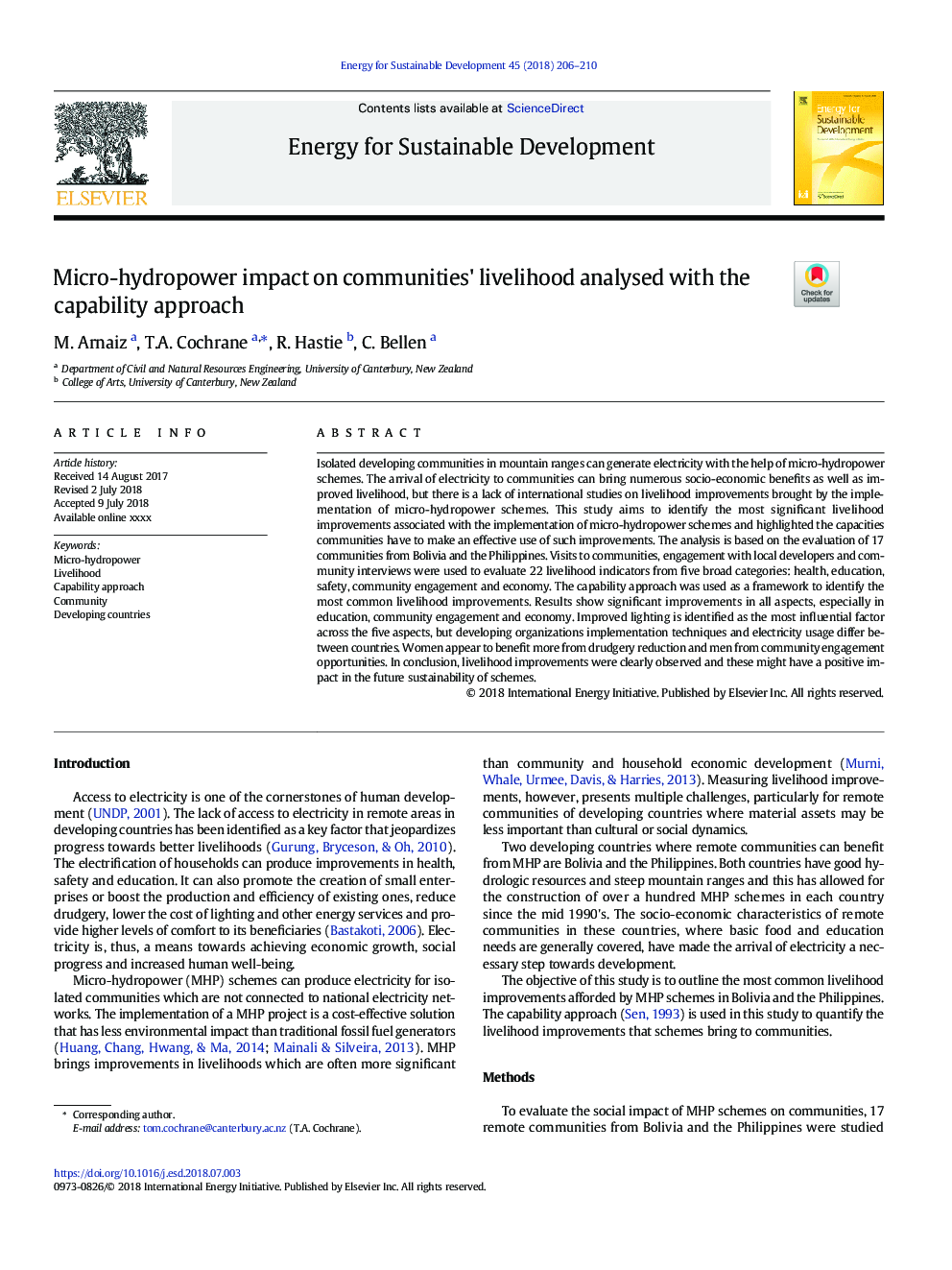| کد مقاله | کد نشریه | سال انتشار | مقاله انگلیسی | نسخه تمام متن |
|---|---|---|---|---|
| 7453533 | 1484385 | 2018 | 5 صفحه PDF | دانلود رایگان |
عنوان انگلیسی مقاله ISI
Micro-hydropower impact on communities' livelihood analysed with the capability approach
ترجمه فارسی عنوان
تأثیر میکرو هیدرولیکی بر شیوه زندگی جوامع، با رویکرد توانایی تحلیل شده است
دانلود مقاله + سفارش ترجمه
دانلود مقاله ISI انگلیسی
رایگان برای ایرانیان
کلمات کلیدی
میکرو آبی، معیشت، رویکرد قابلیت، جامعه کشورهای در حال توسعه،
ترجمه چکیده
جوامع انکشافی جداگانه در محدوده های کوهستانی می توانند با کمک طرح های برق آبی تولید برق تولید کنند. ورود برق به جوامع می تواند مزایای اجتماعی و اقتصادی متعدد و همچنین معیشت معیشت را به ارمغان بیاورد، اما کمبود مطالعات بین المللی در مورد بهبود معیشت ناشی از اجرای طرح های برق آبی کوچک وجود دارد. این مطالعه با هدف شناسایی مهمترین پیشرفت های معیشتی در ارتباط با اجرای طرح های هیدرولیکی کوچک انجام شده و مشخص شده است که ظرفیت های جوامع باید به طور موثر از چنین پیشرفت ها استفاده کنند. این تجزیه و تحلیل بر اساس ارزیابی 17 جوامع بولیوی و فیلیپین است. دیدار با جوامع، تعامل با توسعه دهندگان محلی و مصاحبه های جامعه به منظور ارزیابی 22 شاخص های معیشت از پنج دسته گسترده: بهداشت، آموزش، ایمنی، مشارکت جامعه و اقتصاد استفاده شد. رویکرد قابلیت به عنوان یک چارچوب برای شناسایی شایع ترین پیشرفت های معیشت استفاده شد. نتایج نشان می دهد بهبود قابل ملاحظه ای در تمام جنبه ها، به ویژه در آموزش و پرورش، مشارکت اجتماعی و اقتصاد است. روشنایی بهبود یافته به عنوان عامل مهم ترین در پنج جنبه شناخته شده است، اما روش های پیاده سازی سازمان ها و استفاده از برق بین کشورها متفاوت است. زنان به نظر می رسد از کاهش فقر و مردان از فرصت های مشارکت اجتماعی بهره مند شوند. در نتیجه، پیشرفت معیشت به وضوح مشاهده شد و این ممکن است تأثیر مثبتی در پایداری برنامه های آینده داشته باشد.
موضوعات مرتبط
مهندسی و علوم پایه
مهندسی انرژی
انرژی (عمومی)
چکیده انگلیسی
Isolated developing communities in mountain ranges can generate electricity with the help of micro-hydropower schemes. The arrival of electricity to communities can bring numerous socio-economic benefits as well as improved livelihood, but there is a lack of international studies on livelihood improvements brought by the implementation of micro-hydropower schemes. This study aims to identify the most significant livelihood improvements associated with the implementation of micro-hydropower schemes and highlighted the capacities communities have to make an effective use of such improvements. The analysis is based on the evaluation of 17 communities from Bolivia and the Philippines. Visits to communities, engagement with local developers and community interviews were used to evaluate 22 livelihood indicators from five broad categories: health, education, safety, community engagement and economy. The capability approach was used as a framework to identify the most common livelihood improvements. Results show significant improvements in all aspects, especially in education, community engagement and economy. Improved lighting is identified as the most influential factor across the five aspects, but developing organizations implementation techniques and electricity usage differ between countries. Women appear to benefit more from drudgery reduction and men from community engagement opportunities. In conclusion, livelihood improvements were clearly observed and these might have a positive impact in the future sustainability of schemes.
ناشر
Database: Elsevier - ScienceDirect (ساینس دایرکت)
Journal: Energy for Sustainable Development - Volume 45, August 2018, Pages 206-210
Journal: Energy for Sustainable Development - Volume 45, August 2018, Pages 206-210
نویسندگان
M. Arnaiz, T.A. Cochrane, R. Hastie, C. Bellen,
